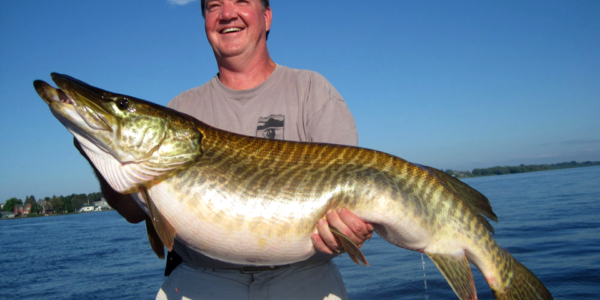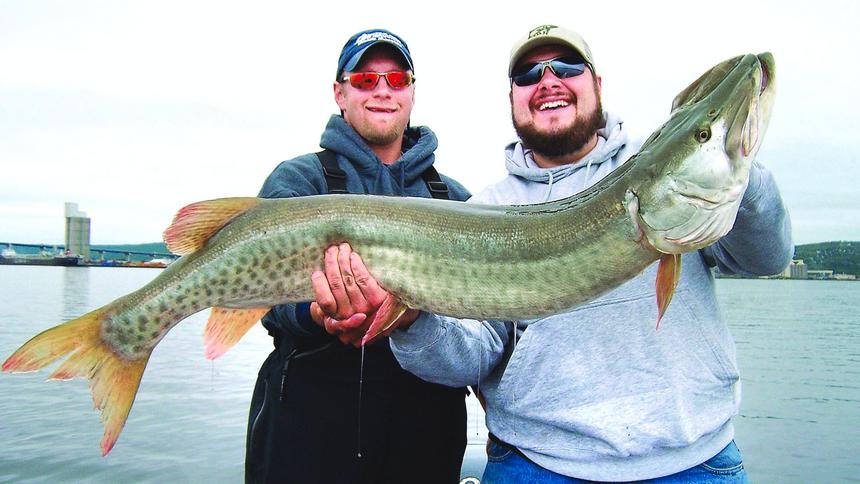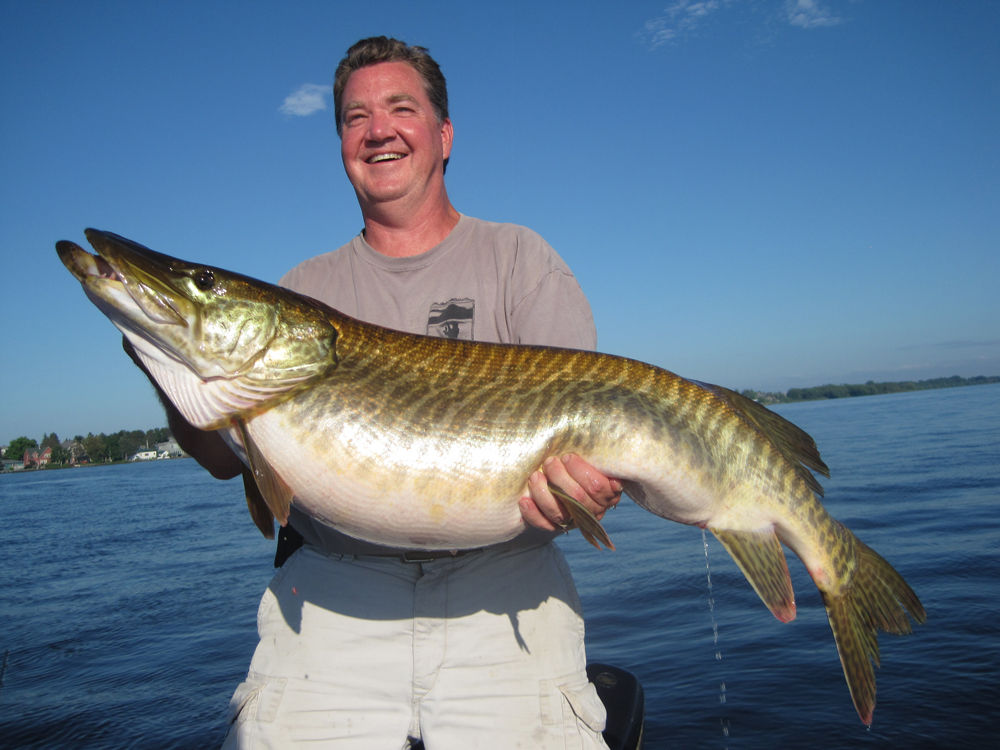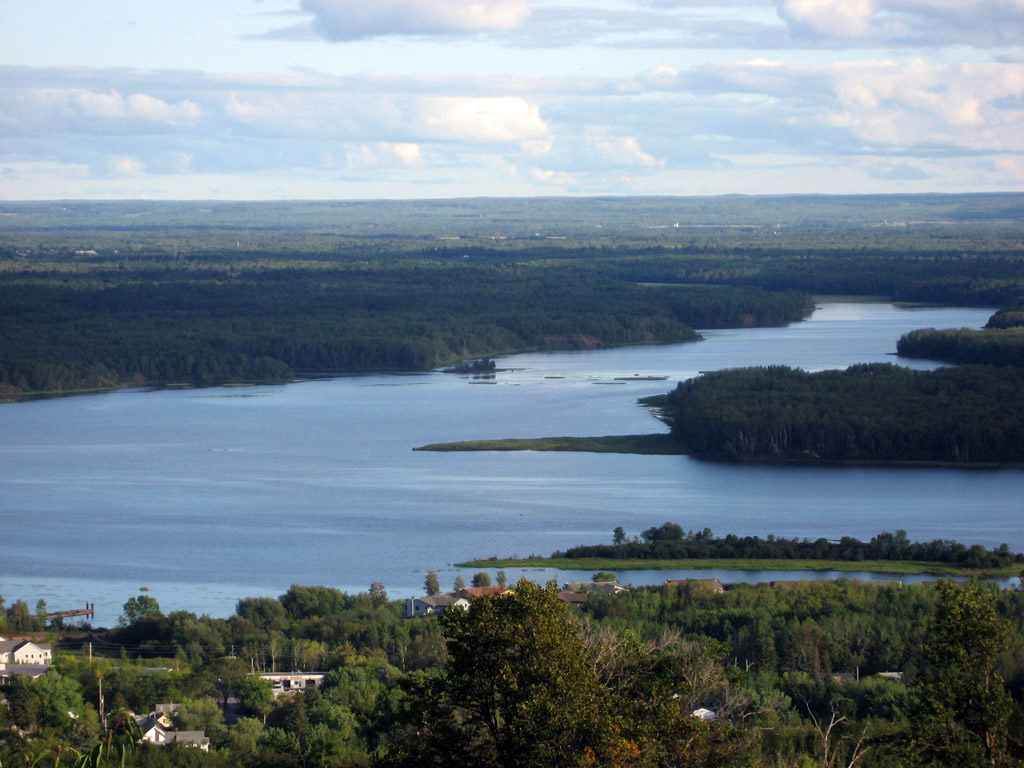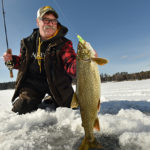Since 2009, many of those who fish muskies on the Lower St. Louis River Estuary (LSLRE) have noticed a steady and dramatic decrease in muskie catches, follows, and sightings. These people include some of the most successful anglers on the river. A fishery that from 2002-2010 would have been described by most as epic, is now largely abandoned by most as it now usually puts up meager results. Large numbers of LSLRE muskie anglers (past and present), think that this is directly due to the discontinuation of muskie stocking in the system; WI in 2004 and MN in 2005. The tremendous value (both sentimental and economic) that had been placed on the muskie resource and fishery in the LSLRE came from both the local community and sources far reaching.
The MNDNR discontinued stocking as part of their long term muskie management strategy for the LSLRE. Some people support the MNDNR in this project, as they think the results might provide valuable information that can be used to more effectively manage muskie waters state wide and beyond. Others do not support the MNDNR, as they do not think it is worth sacrificing a tremendous fishery and are not sure of the potential value of any information gained.
The following paragraphs contain the thoughts of 7 individuals in regard to the MNDNR’s muskie management plan for the Lower St. Louis River Estuary (LSLRE) as well as any future muskie stocking that may or may not take place. Those that are in favor of said management will be featured first in this segment.

Aerial views of Clough Island in the St. Louis River estuary, Duluth, Minnesota.
In Favor
Keith Okeson is the President of the Lake Superior Chapter of Muskies Inc. These are his thoughts on the issue as of early 2015:
“I have no issues with the MNDNR’s management plan (by the way it is also a management plan that the WIDNR supports). Research is one of the cornerstones of MI as it is through research that we continue to grow our knowledge of how to manage Muskie. If this knowledge can be used or applied to other fisheries in our state or elsewhere then it will be a win, win for the fishery. The research on natural reproduction is important and the purpose/goal of stocking is to try to create a self-sustaining fishery. If this can indeed be accomplished it will be a success story while at the same time freeing up resources that can be used elsewhere in the state to help keep our fishery the best it can be. Further the Lake Superior Board supports the management plan as does MI nationally and the Minnesota Muskie and Pike Alliance. We all see the value in working with people that are committed and trained on how to manage this resource. Most people don’t have a fishery degree and so we depend on the knowledge of those that do. There are also some new research techniques that may answer some of the questions on whether Muskie in the St. Louis River are using Lake Superior. If this new research proves to be successful it will be one more management tool that will help define the management of Muskie on the St. Louis River and elsewhere.
The DNR will not resume Muskie stocking on the St. Louis River until the research on natural reproduction is finished in 2017 and all the information that has been collected is reviewed. If the DNR believes that we have a self-sustaining population of Muskies and the population is sufficient and what they are managing for, the river will be considered restored. At that time if our chapter members believe stocking needs to resume we will continue to work with the DNR and let them know our concerns.”
The thoughts of Bob Busche as of early 2015:
“My name is Bob (Robert) Busche. I’ve been a Muskie Inc. member for approx. 20 years, have held numerous officer positions in the Lake Superior Chapter of Muskies Inc. during that time including Treasurer, Secretary, Vice-president and President ; and I’m presently serving as a Board Director At Large. I have been a fisherman for nearly 60 years which includes 20 years fishing for muskie and maintaining a detailed log book of the muskies caught on my boat during that time. Starting in late 2009, I began sharing this information (2002 – 2014) with John Lindgren, MNDNR. Along with this information, I collected scale samples of approx. 250 muskie that were caught on my boat (over a 2-3 year span) which were also forwarded to the MNDNR for DNA and aging tests. Between 2009 thru 2014, my log book shows I personally logged 2,962 hours fishing muskie on the St. Louis River.
I think the DNR’s management plan is the proper approach based on what I know to this point. While this plan may not immediately resolve the present, lower (than in recent past) population of trophy muskie in the St. Louis River, I believe they are attempting to use their limited resources to obtain more factual information needed to make an informed decision which can be supported/justified by analytical facts.
While I’m not apposed to stocking the river with more muskies in the future, I would be inclined (based on known facts to date) to support the DNR’s decision to not stock muskie since that is what our chapter as a whole wishes to do at the present time.”
The thoughts of John Underhill as of early 2015:
“I’m John Underhill Co-chair of the Minnesota Muskie and Pike Alliance. I’m also the fishing organization representative for the Clean Water Council. I’m member of the DNR Esox Workshops and a former VP of Southern Crossroads Chapter 54 Muskies Inc..
The fundamental principles of Muskies Inc. are Youth, fisheries research. Supporting the fisheries through our belief that research will provide us a quality fishery for the youth of tomorrow and today. We support research and education with manpower, funding and dissemination of information gained through research. This is our responsibility to the fish for their continued success. Assumptions, beliefs and on the water observations have the potential for both positive and negative outcomes.
When we offer these thoughts for the provocation of a solution to potential problems we all win. If we offer these thoughts without the patience or willingness to accept a conclusion that doesn’t reinforce our preconceived notions, and we go against the research and discovery; we initiated, we will assuredly do more damage to our fish and our credibility. Hampering the future of Muskie stocking and management by short circuiting the learning process is against the foundation of our organization We have a great opportunity to have a better understanding of our fishery.
If at the end of the research they discover future stocking is required for a viable fishery then the DNR will meet that need and will welcome our involvement as they always have. If it shows they don’t require further stocking to maintain the fishery; then their fingerlings can be used in other waters that’s something we’ll also have to understand. If anglers want to stock fish in a body of water that will not benefit from stocking; but the DNR grants them a stocking permit, I don’t see a problem with that either.”
At the time of this response (early 2015), Carl Phillips is the Treasurer of the Minnesota Muskie and Pike Alliance (MMPA) and president elect of Muskies Inc., these are his thoughts:
“My understanding is that the MNDNR is studying the St Louis River until 2017 to determine 1) the level of natural reproduction occurring in the river and 2) the appropriate density of muskies for that fishery. I am in complete support of this study. Knowledge is everything when it comes to fisheries management. The outcome of this study can be important here and elsewhere. MI has always supported the various DNRs in their efforts. It would be short-sighted to say the least to change courses this far into the study. Furthermore MI has and will continue to hold symposiums for scientists to exchange knowledge and further the DNR’s ability to manage to a goal. This study may prove to be extremely valuable. We are learning more and more about the density of muskies and the repercussions of any stocking effort. But we are in our infancy relative to ultimate knowledge.
Your third question is not as simple as one might think. We do not know the outcome of the study. Further, if we suppose that the DNR determines that there is sufficient natural reproduction occurring in the system, we do not know the basis of this opinion nor do we know the repercussions of an excessive density relative to other biomass. In other words we would be putting the cart before the horse if we were to suppose a position without knowing all of the facts. And we do not know all of the facts. I can say that when we have an opinion that differs with a DNR we have always worked with them to get to common ground.
Opposed
Dustin Carlson, owner of northland muskie adventures, has had huge success guiding clients on the LSLRE over the years. Carlson has volunteered many hours to fishery efforts, and is disappointed by the current state of the resource. Like many others, Carlson strongly thinks that research is important to the future of muskie fishing, but he also thinks a different approach should have been taken in this scenario. Dustin thinks it is necessary to resume the stocking of MN Leech Lake strain muskies in the LSLRE to return the fishery to its former glory. Carlson’s reason for this is that he thinks there is not sufficient natural reproduction to sustain a quality sport fishery. Many anglers who target muskies in the LSLRE agree, even if it means collecting the necessary funds themselves.
Carlson’s catch rates have severely declined in past years (see figure 1-1). Pete Brzezinski is another successful guide who has spent many hours on the LSLRE and has experienced the same disturbing trends in catch rates (see figure 1-2). In fact, one would be hard pressed to find a LSLRE muskie angler who has not experienced the same frustrating results. The common sentiment among anglers is that the fish are just not there like they used to be, and they don’t want to see the fishery completely crash before something is done to fix it.
Figure 1-1
2003 716 hours fished 131 muskies boated 5.4 hours per catch
2004 856 hours fished 166 muskies boated 5.1 hours per catch
2005 812 hours fished 174 muskies boated 4.6 hours per catch
2006 924 hours fished 189 muskies boated 4.8 hours per catch
2007 717 hours fished 148 muskies boated 4.8 hours per catch
2008 841 hours fished 191 muskies boated 4.4 hours per catch
2009 906 hours fished 168 muskies boated 5.4 hours per catch
2010 811 hours fished 112 muskies boated 7.2 hours per catch
2011 722 hours fished 86 muskies boated 8.3 hours per catch
2012 646 hours fished 46 muskies boated 14 hours per catch
2013 528 hours fished 23 muskies boated 22.9 hours per catch
Figure 1-22006 887 hours fished 183 muskies boated 4.8 hours per catch
2007 792 hours fished 166 muskies boated 4.7 hours per catch
2008 918 hours fished 221 muskies boated 4.1 hours per catch
2009 944 hours fished 167 muskies boated 5.6 hours per catch
2010 826 hours fished 96 muskies boated 8.6 hours per catch
2011 721 hours fished 77 muskies boated 9.3 hours per catch
2012 411 hours fished 14 muskies boated 29.3 hours per catch
2013 523 hours fished 28 muskies boated 18.6 hours per catch
Dustin Carlson Photo / St. Louis River Musky
Carlson is proud of the positive relationship that Muskies Inc. has had with the MNDNR and doesn’t want anything to jeopardize that. However, like so many others, he sees the writing on the wall in this situation and has been greatly affected by the decline of the fishery in the LSLRE. Carlson must now guide on waters further from home, as he can no longer book more than a few clients on the LSLRE. Fuel and lodging costs cut deeply into his profit margins, and the travel decreases the amount of time he is able to spend with his family.
These are the thoughts of Bob Benson as of early 2015:
“My name is Bob Benson – I’m a diehard Muskie fisherman and have been fishing muskies for around 45 years (I’ll turn 50 this fall). The last 15 years I’ve spent the bulk of my time in Northeastern Minnesota splitting time between the ST Louis River and Lake Vermilion. I’ve pretty much given up on the St. Louis as a quality Muskie fishery at this point. With my age combined with the lack of urgency to repair the fishery it is unlikely that I’ll see a return in my lifetime.
I believe that the DNR plan (self sustaining fishery) for the ST. Louis has already been successful. They have a self sustaining Muskie fishery firmly established. There is natural reproduction occurring every year, and a small number of muskies will likely always exist in this vast fishery.
The second question is really the main issue. Assuming that we have a self sustaining fishery – it comes down to choosing from two options:
1. Don’t stock and have a fishery that is just ok, but doesn’t compare to what we had in the past. It certainly doesn’t compare favorably to the heavily stocked lakes in western Minnesota or destinations like Lake Saint Clair. This is a disappointing choice for a spectacular resource in a unique urban area. The issue around expense is also debatable, as the Muskies that would have been stocked in the St. Louis river went to Western MN where abnormally high stocking rates continue.
2. Manage the fishery to be the high quality resource it was in the past. I’m always surprised when the goal is something less than to have the best fishing possible.
Short answer – yes, I’d like to the St. Louis river stocked again. The current trajectory of the St Louis Muskie population makes it likely that I won’t see the next peak in my lifetime, I’m hoping that my children will see it. Until then we’ll go to Western Minnesota where stocking rates have remained high for the last decade.
I would like the DNR to explain why the stocking rates are so much higher in Western Minnesota than other areas of the state? It would seem that the people and businesses in other areas deserve the same attention. I feel bad for this generation of kids growing up around the St. Louis river that will miss out on the tremendous fishing of 5-10 years ago. No one is accountable – just point at “the plan”. In the mean time keep stocking all the Muskies in Detroit, Pelican, Miltona, Battle, Plantagenet etc. and hope no one notices. “It’s the Plan”. Note to all: Before you go fishing check to see how many fish per acre get stocked at your destination. In the St. Louis River the answer in ZERO.”
These are the thoughts of James Gotham as of early 2015:
“I have learned a great deal about the St. Louis River/Estuary over the seven years that I worked as a fisheries technician for the Wisconsin Department of Natural Resources (WDNR). During my seven years with the WDNR I had assisted in the management of all species in the St. Louis system. I saw how both human and environmental influences affect the fishery. I also grew up fishing the St. Louis since I was three years old. During my childhood I grew to love fishing muskies on this system. The more I fished for them, the more enjoyed the sport. It got to the point where I was chasing muskies 4-6 times per week; then it got to the point where I dedicated my fishing career to muskies.
Because of my former employment with the WDNR I try to maintain a neutral position between how the DNR manages the muskies in the fishery, and my passion for muskie fishing. That being said, I am also more critical of how the DNR manages the fishery and what muskie fisherman can expect from their tax dollars.
There is no denying the flood of 2011 reconstructed the St. Louis. The DNR and muskie fisherman have both had to take a step back and look at if the DNR needs to reinstate its stocking program. I worked for the DNR during the pre-flood era. During my employment we did bi-weekly seining surveys, where we looked at the recruitment of multiple species by collecting data of young of the year (YOY). We had nine different sienging stations that ranged through most the St. Louis River fishery. Each station was 100 ft long and seined with a 100 ft. net. In all nine stations we monitored the growth rates and numbers of YOY of multiple game fish and bait fish species. It was very clear that our data showed the St. Louis System was a highly fertile system with high amounts of game fish and bait fish. Out of my seven years of completing these surveys it was extremely rare to catch more than 5 YOY muskies a year. It should be known that most of the siening stations were located in or near areas that muskies would spawn. These numbers would show significant data that muskie recruitment is poor.
The DNR fyke netting muskie assessment is done every five years. Both WDNR and Minnesota Department of Natural Resources (MNDNR) teamed up to set up fyke net stations. These assessments show that there was musky recruitment in the system. That being said, this assessment was done once every five years because of how stressful it is on fish; is this significant data? Five years is a long timespan, especially since the success or failure of the assessment is determined based on water temperatures that dictate the muskie spawn. For example, if there is a late or early spring the week of the assessment the DNR could miss the spawn or hit the spawn dead on. This unpredictable situation has potential to yield skewed numbers, raising the question, “Is this data is useable?”
How do we assess the muskie population and recruitment? If the population and recruitment is good, then you do not want to ‘dumb down’ the species by adding stocked fish. There is no question that natural reproduction promotes a healthier species, but also healthier ecosystem. On the other hand, do our muskie numbers support a fishable population? It is the fishable population that brings money to our economy and pays the DNR’s paychecks.
It is my personal opinion that we no longer have a fishable population in the St. Louis system. In addition to the poor numbers, many local businesses have been affected. Lodging establishments, musky guides, and bait stores have all seen a decline in business. In addition, no muskie tournaments been held here since the flood and the ones who try cannot fill a roster. Lastly, online muskie forums are telling people to stay away from the area like we have been infected by the black plague. To me these are the true indicators of our declining muskie population. Muskie fisherman are a tough group of fisherman for the most part, they can accept going days without a fish — but not months.
Will we ever see the St. Louis become the fishery it once was? I don’t believe so. I believe before the flood we saw the peak of the DNR’s stocking efforts. There is alway an apex curve when initial stocking is done in a body of water. But, I think we can improve numbers from where they are now. I hope that the WNDR and MNDNR can work together with fisherman to fully understand this fishery and restore not only the muskie population, but our economy as well.”
Dustin Carlson Photo / St. Louis River Musky
Interview with Deserae Hendrickson
The following is an interview I conducted with Deserae Hendrickson, Duluth Area Fisheries Supervisor with the MNDNR in March and April of 2016. My questions are in blue font, her responses are in black font.
Does the MNDNR think there has been a decline in the muskie fishery in the St. Louis River, and if so what are the causes?
Based on results of the Muskie assessment netting, there was no indication the Muskie population has declined, as the highest net catches were observed in 2013. During the last two assessments, mark-recapture population estimates of spawning adult Muskie (> 30 inches) were also completed utilizing the assessment catch and angling data provided by a number of Muskies Inc. members. These estimates indicated an increase in the adult Muskie population between 2010 and 2013, from 1,507 to 3,235. The confidence intervals on these estimates did overlap slightly, so it is possible that there was very little change in the actual number of fish in the population between these two time periods.
Many muskie anglers have experienced a dramatic decline in the muskie fishery in the St. Louis River. Many of these anglers think that this is due to a decline in muskie population in the St. Louis River. How does the MNDNR respond to this?
While the assessment information did not indicate a population decline, there are many other possibilities for declines in angler catch rates. These might include changes in fish behavior, seasonal emigration out of the estuary into Lake Superior, and/or changes in habitat location and/or use from historical locations. There were very significant changes in estuary habitats following the flood of 2012.
Going forward, what is the MNDNR’s plan for muskie management/study in the lower St. Louis River?
Future study of Muskie in the St. Louis River includes:
- 1) Annual assessments with electrofishing to verify natural reproduction (presence of young-of-year)
- 2) Trapnet assessments of spawning adults in 2017 and 2018, including population estimates. The results of the 2017 assessment are key to future management decisions, as this will be the first spawning adult assessment where most of the sampled fish will be from wild year-classes.
- 3) Evaluation of time spent feeding in the St. Louis Estuary vs. Lake Superior utilizing stable isotope analysis (cooperative project with USEPA and Muskie Inc. Lake Superior Chapter).
- 4) Continued genetic analysis of naturally-produced offspring to determine parental origin: Leech Lake or Wisconsin strain (cooperative project with Muskies Inc. Lake Superior Chapter and University of MN).
- 5) Acoustic telemetry study in 2017 and 2018 to better characterize Muskie movement and habitat use (cooperative project with University of MN)
The amount of activity directed at Muskie management in the estuary is considerably more than most waters managed for Muskies.
Many St. Louis River muskie anglers think there was never a viable sport fishery for muskies in the St. Louis River until one was created by stocking. How does the MNDNR respond to these thoughts?
MNDNR has not found adequate historical documentation to know whether this is the case. Regardless of what was present in the past, the MNDNR goal for the future includes managing for a viable Muskie sport fishery.
Many muskie anglers who have experienced a decline in the muskie fishery in the St. Louis River think the decline was caused by the cessation of stocking, and that there will not be a viable sport fishery for muskies in the St. Louis River until stocking resumes. How does the MNDNR respond to these thoughts?
MNDNR is aware of these concerns, and will address them after evaluating the data from the 2017 population estimate.
Many St. Louis River muskie anglers think there is neither sufficient natural reproduction nor enough remaining adult population to support a naturally reproducing sport muskie fishery in the St. Louis River. How does the MNDNR respond to these thoughts?
Documentation by MNDNR of natural reproduction in young-of-year assessments every year since cessation of stocking would suggest that there is a sufficient population of adults. What is yet to be determined is whether adequate numbers are produced, and survive to spawn and contribute to the fishery. That is what the 2017 assessment is intended to identify. In the 2014 assessment, there was already significant recruitment of wild fish into the adult sample (27% of total fish captured).
Please explain exactly why the MNDNR will not allow muskie stocking to resume in the St. Louis River when so many people want stocking to resume and are willing to raise the necessary funds privately.
Stocking has not been permitted to avoid confounding evaluation of the St. Louis Estuary’s potential for a naturally reproducing fishery. Stocking can affect condition factors and reduce survival of wild fish trying to compete within the same waterbody. Regular stocking can also negatively impact the long term genetic fitness of the population. There was excellent Muskie production in MN in 2015, resulting in surplus fingerlings being available last fall. MNDNR stocked 2190 fingerling surplus Muskies into the St. Louis Estuary in November 2015, but tagged the stocked fish with PIT tags so they could be identified in future sampling. It was determined these young fish would not interfere with the evaluations in 2017-18 because they would not be large enough to be sampled in the 2017 and 2018 trapnet surveys. The tagged stocked fish may also assist in evaluating the relative strength of the 2015 natural year-class in future surveys. If the 2017 and 2018 evaluations do not show adequate recruitment of wild Muskie, MNDNR will evaluate stocking options to meet management goals at that time.
Conclusion
People seem to be very divided on this issue and steadfast in their thoughts regardless of where their views align. Inevitably, emotions run high in such scenarios as people await the outcome. At this point, the plan of the MNDNR is in place, and until the fall of 2015 it seemed highly unlikely that any stocking would take place any time soon.
The goal of this article is to raise awareness concerning this issue. Scrutiny should be focused on the St. Louis River by all those concerned about the future of muskie fishing. If the knowledge gained by this management strategy indeed proves to have widespread beneficial results, then the MNDNR will gain credibility, even if it has come at a great price. If there is no proof of benefit, people will have the right to be much more suspicious of such management plans and will need to be much more vigilant of all changes to fisheries management plans on waters they care about.
According to the numbers provided by the MNDNR, stocking 3,000 muskies into the LSLRE would cost roughly $45,000. The two year budget of the MNDNR for 2014 and 2015 was 890.2 million dollars. Regardless of what each individual thinks about the future of muskies in the LSLRE, the thoughts of every concerned individual should be brought to the attention of the MNDNR by emailing duluth.fisheries@state.mn.us.
Dustin Carlson Photo / St. Louis River Musky
END NOTES – Muskies Inc. has a very positive long standing cooperative relationship with natural resource management entities across the United States and Canada. I am very proud of this relationship and like most other educated and knowledgeable muskie anglers, I think relevant scientific research and intelligent management is very important to the future of muskie fishing. That being said, every situation we encounter must be closely scrutinized and examined from all angles (both scientific and human) to make sure that nothing is missed. That is what this article attempts to do.
I initially researched and wrote this article in 2014 and 2015. My intention was that it be published in MUSKIE in 2015. In 2015, MUSKIE declined to publish this article so I decided to publish it in my newsletter that I had already planned on starting at the time. Creating this article was an extensive undertaking. I listened carefully to the thoughts of others who examined it prior to publishing. Many were displeased with the situation the article describes. Many were displeased with the article itself.


